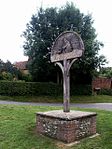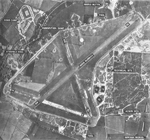Hethersett
AC with 0 elementsCivil parishes in NorfolkHethersettVillages in Norfolk

Hethersett is a large village and electoral ward in the county of Norfolk, England, about 6 miles (10 km) south-west of Norwich. It covers an area of 4.22 sq mi (10.9 km2) and had a population of 5,441 in 2,321 households at the 2001 census, increasing to 5,691 at the 2011 census. In 2013 Hethersett became the first village or town in the United Kingdom to receive a Prime Minister's Big Society Award for its outstanding contribution to the Olympic legacy and sport and fitness in general.
Excerpt from the Wikipedia article Hethersett (License: CC BY-SA 3.0, Authors, Images).Hethersett
Henstead Road, Norwich
Geographical coordinates (GPS) Address Nearby Places Show on map
Geographical coordinates (GPS)
| Latitude | Longitude |
|---|---|
| N 52.601 ° | E 1.179 ° |
Address
Henstead Road 2a
NR9 3JH Norwich
England, United Kingdom
Open on Google Maps








